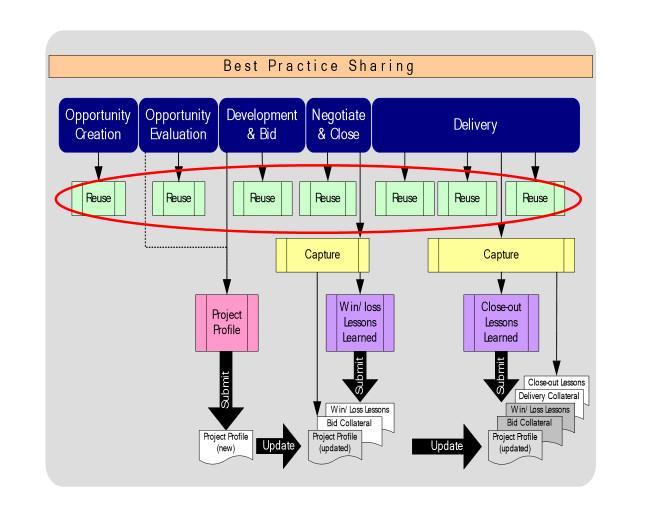KM Component 16 – Lessons Learned Process

Stan Garfield
In the practice of KM, a lessons learned process involves explaining what an individual or team has learned as a result of their experience.
This is done using databases, documents, presentations, discussions, and recordings. Lessons learned include what was tried, what worked, what didn’t work, what to do, what to avoid, problems faced, how problems were solved, what to differently the next time, and key insights and knowledge nuggets.
It’s easier to get people to talk about successes than about failures, but there is often more to be learned from the latter. Designing a process to capture and reuse lessons learned from both can yield great benefits.
Lessons learned can be written down and stored in a repository, presented during a community meeting and recorded for later playback, and discussed in a roundtable on a conference call. A facilitator can collect individual lessons learned from multiple people and compile them in a summary document.
Avoid capturing generic platitudes such as “it’s important to have a good plan” or “involve support groups early.” Instead, look for nuggets such as “use one extra ounce of grease to lubricate the subassembly during routine maintenance to prevent engine failure.”
Provide ways for lessons learned to be presented and discussed during community events. Don’t just publish them in a document or in a database.
Once an initial collection of lessons learned has been published, ensure that it is periodically reviewed and updated. This should be part of the standard process for capturing, publishing, and maintaining lessons learned.
Consider scheduling a separate recurring conference call during which a team or individual is asked to discuss their lessons learned. Record the calls and write down the best ideas for publication.
Benefits
- Enabling better and faster decision making: The reuse of knowledge in repositories allows decisions to be based on actual experience and practical lessons learned.
- Avoiding making the same mistakes twice: If we don’t learn from our mistakes, we will experience them over and over again. Knowledge management allows us to share lessons learned, not only about successes, but also about failures. In order to do so, we must have a culture of trust, openness, and reward for willingness to talk about what we have done wrong. The potential benefits are enormous. If NASA learns why a space shuttle exploded, it can prevent recurrences and save lives. If FEMA learns what went wrong in responding to Hurricane Katrina, it can reduce the losses caused by future disasters. If engineers learn why highways and buildings collapsed during a previous earthquake, they can design new ones to better withstand future earthquakes. If you learn that your last bid was underestimated by 50%, you can make the next one more accurate and thus earn a healthy profit instead of incurring a large loss.
10 Ways to Enable Lessons Learned
- Nurture a knowledge sharing culture in which failure during innovation is encouraged, as long as the lessons learned are shared so that similar failures are prevented.
- Set an objective to increase profits by sharing and reusing lessons learned.
- Implement lessons learned strategies:
- Motivate: reward sharing and reusing lessons learned.
- Supply: capture lessons learned.
- Analyze: select best lessons learned.
- Codify: categorize and tag selected lessons learned.
- Disseminate: send out lessons learned in email messages.
- Demand: provide a query capability for the lessons learned database.
- Act: reuse lessons learned.
- Require that lessons learned documents be submitted to a repository for each project. Set a goal for submitting lessons learned. Measure this goal by the number of lessons learned submitted and the number of unique contributors divided by number of employees.
- Reward the capture and reuse of lessons learned. For example, for every lessons learned document that is applied, both the contributor and the person applying it earn gift certificates.
- Review collected information to reveal patterns, trends, or tendencies that can be exploited, expanded, or corrected. Knowledge can be harvested in the form of lessons learned.
- Embed lessons learned in workflow. For example, a project management system prompts project managers to enter lessons learned reports at appropriate times. Or when sales are closed, and sales reps enter requests for commission payments, they are prompted to enter data into a form that captures lessons learned about the deal.
- Use stories. Lessons learned can be captured and reused with greater impact if they are told as stories, rather than captured as imperatives in text format. Get teams to discuss lessons learned on podcasts. The knowledge will be more effectively shared than if the same information was written down and submitted to a database.
- Hold con calls featuring conversations about lessons learned. Hold other calls with speakers sharing lessons learned from failure.
- Share lessons learned in communities. Encourage community members to learn from other members of the community and from invited guest speakers about successes, failures, and case studies.
Methods
Here are three KM methodologies for lessons learned.
- After Action Review was developed in the US Army and is now widely used to capture lessons learned, both during and after an activity or project.
- Peer Assist is a tool developed at BP-Amoco used to learn from the experiences of others before embarking on an activity or project.
- Retrospect is a structured and facilitated knowledge capture meeting at the end of a project, involving as many of the project team as possible. It is a quick and effective way of capturing knowledge before a team disbands. If a member from the next team to undertake a similar business challenge participates in the discussion, a retrospect for one team can serve as a peer assist for the next one.
For a case study on how a lessons learned process was integrated into the project lifecycle at HP, see Chapter 15 in Proven Practices for Promoting a Knowledge Management Program. Here is a diagram showing the stages at which lessons learned were required to be captured:

For more about lessons learned, see the SIKM Leaders Community Discussions.

Stan Garfield
Please enjoy Stan’s additional blog posts offering advice and insights drawn from many years as a KM practitioner. You may also want to download a copy of his book, Proven Practices for Implementing a Knowledge Management Program, from Lucidea Press. And learn about Lucidea’s Inmagic Presto and SydneyEnterprise with KM capabilities to support successful knowledge curation and sharing
Similar Posts
Only You Can Prevent Knowledge Loss: How to Practice “Knowledge Archaeology”
An overview of ways in which knowledge is lost, with examples of how to perform knowledge archaeology to recover and restore it.
Ready to Read: Profiles in Knowledge: 120 Thought Leaders in Knowledge Management
We are pleased to announce that Stan Garfield’s new book, Profiles in Knowledge: 120 Thought Leaders in Knowledge Management, is now available from Lucidea Press.
Lucidea’s Lens: Knowledge Management Thought Leaders Part 92 – Jay Liebowitz
Jay Liebowitz is a professor, consultant, author, and editor. His research interests include knowledge management, data analytics, intelligent systems, intuition-based decision making, IT management, expert systems, and artificial intelligence.
Lucidea’s Lens: Knowledge Management Thought Leaders Part 91 – Frank Leistner
The late Frank Leistner was the former Chief Knowledge Officer for SAS Global Professional Services, where he founded the knowledge management program and led a wide range of knowledge management initiatives up until 2012.




Leave a Comment
Comments are reviewed and must adhere to our comments policy.
0 Comments